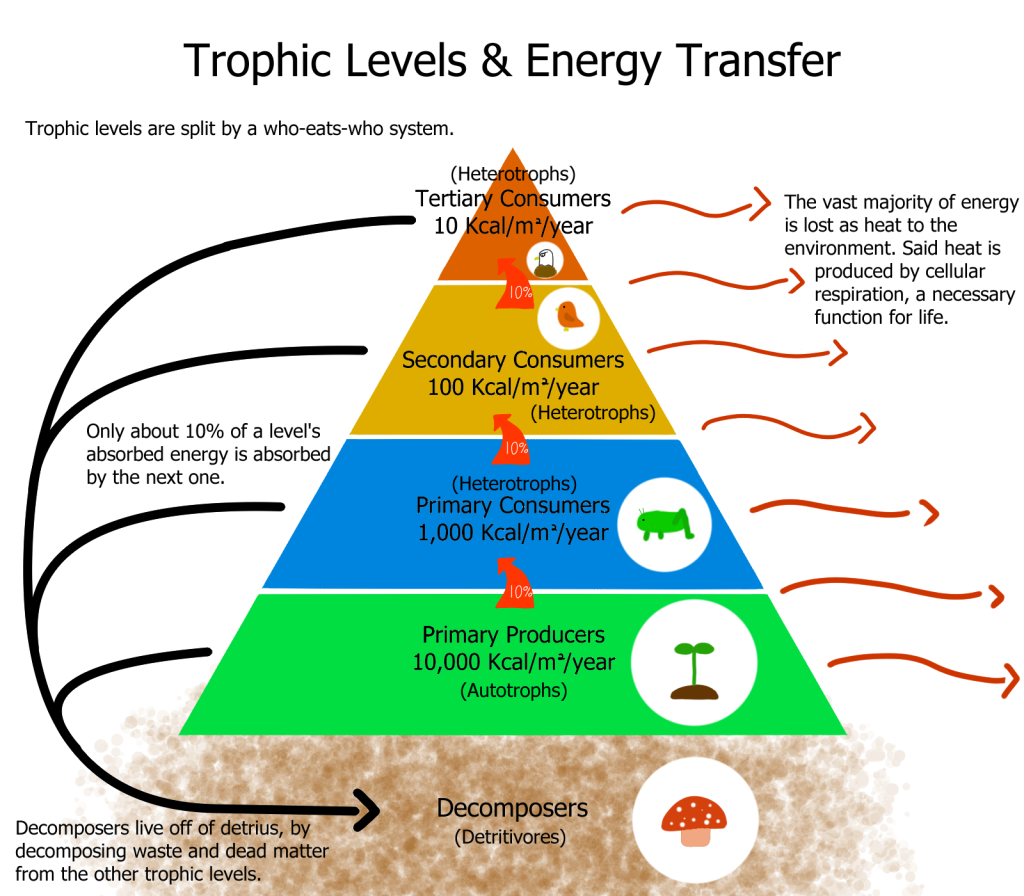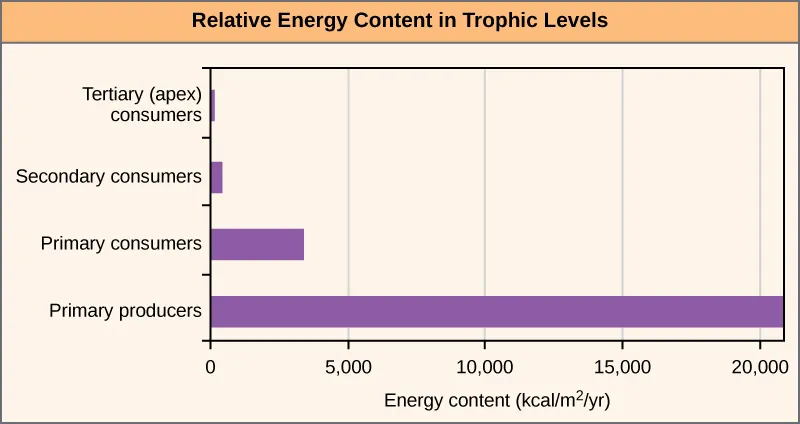IB Syllabus focus:
‘Fraction of energy transferred between trophic levels varies by ecosystem, level, and species; the “10% rule” is not fixed or universal.’
Energy transfer in ecosystems is central to understanding ecological dynamics. Ecological efficiency describes how much energy passes between trophic levels, but this process varies considerably across ecosystems, species, and conditions.
Defining Ecological Efficiency
Ecological efficiency measures the proportion of energy or biomass transferred from one trophic level to the next in a food chain or food web.
Ecological Efficiency: The percentage of energy assimilated at one trophic level that is passed on to the next trophic level.
This concept provides insight into food chain length, biomass pyramids, and sustainability of energy use in ecosystems.
The “10% Rule” and Its Limitations
A commonly cited principle is the “10% rule”, suggesting that only about 10% of energy is transferred between levels. For example, 10% of producer energy supports herbivores, while the rest is lost through respiration, heat, or waste. However, this rule is not universally accurate.
Some transfers may be lower (5% or less) in less efficient systems.
Others may be higher (20–30%) in highly efficient systems.
Variability arises from species physiology, ecosystem type, and trophic interactions.
Energy Losses Between Trophic Levels
Energy transfer is never 100% efficient because energy is lost at each stage.

A trophic energy pyramid illustrating transfers from producers to higher trophic levels and the fates of non-transferred energy (e.g., heat, respiration/waste). The labels foreground why efficiency is always less than 100% and varies among taxa and ecosystems. This is a general schematic; percentages shown elsewhere (e.g., “10%”) are heuristics rather than universal constants. Source.
Key losses include:
Respiration: Organisms use energy for metabolism, releasing heat.
Excretion and egestion: Energy lost in waste materials and undigested food.
Incomplete consumption: Not all biomass is eaten (e.g., roots, bones, shells).
Maintenance activities: Energy used in movement, thermoregulation, and reproduction.
These losses explain why higher trophic levels have smaller populations and biomass.
Factors Affecting Ecological Efficiency
Ecosystem Type
Aquatic ecosystems often show higher transfer efficiencies than terrestrial ones. Aquatic herbivores (like zooplankton) consume nearly all available phytoplankton, boosting transfer.
Terrestrial ecosystems often lose more energy, as plants may have indigestible components (lignin, cellulose) and less herbivory pressure.
Trophic Level
Lower levels (producer → herbivore) usually show higher efficiency than higher levels (carnivore → top predator).
Efficiency declines with increasing trophic level due to accumulated energy losses.
Species and Physiology
Poikilotherms (cold-blooded animals) generally convert energy more efficiently than homeotherms (warm-blooded animals), since they expend less energy on thermoregulation.
Species with simpler digestive systems may assimilate less efficiently than those with specialised digestion.
Environmental Conditions
Abiotic factors like temperature, light, and nutrient availability can alter photosynthetic efficiency and herbivore feeding rates.
Seasonal changes influence energy flow, particularly in temperate ecosystems.
Measuring Ecological Efficiency
Ecological efficiency is expressed as a ratio or percentage:
Ecological Efficiency (EE) = (Energy at higher trophic level ÷ Energy at lower trophic level) × 100
EE = Percentage efficiency of energy transfer
For example, if herbivores consume 1000 units of plant energy and convert 100 units into biomass, their ecological efficiency is 10%.
Ecological Efficiency and Food Chain Length
The limited efficiency of energy transfer restricts the number of trophic levels in most ecosystems.

Relative energy content across trophic levels in the Silver Springs ecosystem, showing steep declines from producers to tertiary consumers (kcal m⁻² yr⁻¹). This real-world example demonstrates how limited transfer efficiency constrains trophic length and why values differ among ecosystems. Values here are specific to Silver Springs and should not be generalised as a universal “10% rule.” Source.
Typically:
Terrestrial ecosystems: 4–5 trophic levels.
Aquatic ecosystems: sometimes extend to 6–7 levels due to greater transfer efficiency.
This explains why apex predators are rare and why ecosystems support fewer top carnivores.
Implications for Human Use of Resources
Humans occupy multiple trophic levels depending on diet. Ecological efficiency helps explain sustainability:
Diets based on lower trophic levels (plants) use energy more efficiently, supporting more people with the same resources.
Diets rich in animal products, particularly from higher trophic levels, involve greater energy losses and lower sustainability.
This principle links ecological efficiency to food security, agricultural choices, and environmental sustainability.
Key Takeaways
Ecological efficiency is highly variable, influenced by species, ecosystem type, trophic level, and environmental factors.
The 10% rule is a generalisation and not universally valid.
Energy losses at each transfer shape biomass pyramids, food chain length, and population sizes.
Human food choices and resource use are directly connected to principles of ecological efficiency, highlighting its relevance to sustainability.
FAQ
Detritivores and decomposers recycle nutrients and energy from dead organic matter back into the system. While they do not transfer large amounts of usable energy to higher trophic levels, they maintain soil fertility and nutrient cycling, indirectly supporting primary productivity. Their role ensures ecosystems avoid complete energy and nutrient loss by breaking down otherwise inaccessible biomass.
In aquatic systems, producers such as phytoplankton are small, soft-bodied, and highly digestible, meaning herbivores can consume a larger proportion of available biomass.
By contrast, many terrestrial plants contain cellulose, lignin, and defensive compounds, making much of their biomass indigestible or unpalatable. This results in less energy transfer from plants to herbivores and lower overall efficiency.
Smaller organisms often have higher metabolic rates, leading to greater energy loss as heat through respiration.
Larger organisms may be less energy-efficient at producing biomass relative to intake, but they often have longer lifespans and more efficient food utilisation. Body size also shapes predator–prey dynamics, with energy transfer efficiencies reflecting the balance between metabolic demands and assimilation rates.
Yes, efficiency varies across different species and food chains even within one ecosystem.
Herbivores consuming nutrient-rich plants may show higher efficiency than those feeding on fibrous plants.
Predators of soft-bodied prey typically assimilate more energy than predators of prey with hard shells or bones.
Seasonal changes can further alter efficiency, especially in temperate climates where productivity fluctuates.
Food systems based on lower trophic levels (e.g., grains, legumes, vegetables) are more energy-efficient, requiring fewer resources per unit of food energy available to humans.
Animal-based diets, particularly from higher trophic levels like carnivorous fish or livestock fed on grain, involve additional energy losses at each stage. Shifting diets to plants or herbivorous species increases sustainability and aligns human consumption more closely with ecological efficiency principles.
Practice Questions
Question 1 (2 marks)
Explain why the “10% rule” for energy transfer between trophic levels is not universally valid.
Mark Scheme:
1 mark for stating that energy transfer efficiency varies depending on factors such as species, trophic level, or ecosystem type.
1 mark for recognising that actual transfer can be higher or lower than 10% (e.g., 5% or 30%).
Question 2 (5 marks)
Discuss the factors that influence ecological efficiency between trophic levels and explain how these affect the length of food chains.
Mark Scheme:
1 mark for identifying ecosystem type (e.g., aquatic vs terrestrial).
1 mark for identifying trophic level differences (lower vs higher levels).
1 mark for mentioning species physiology (e.g., poikilotherms vs homeotherms).
1 mark for identifying environmental/abiotic conditions (e.g., temperature, nutrient availability).
1 mark for explaining the link to food chain length (limited efficiency restricts trophic levels, usually 4–5 on land, more in aquatic systems).

